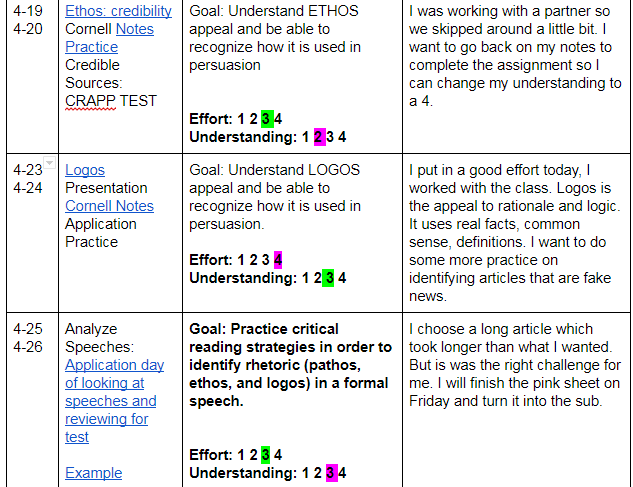A Framework that Connects Learning to the Standards
With our personalized learning framework the learners can see how all content learned prepares them for meeting a standard. We outline the standards for an entire unit for the learners, and each day we give them a goal to reach or have them set their own goal for the class (sample unit guide). The daily goals are directly connected to standards and give learners measurable data to consistently track their effort and understanding. When the purpose is clear (the why/daily learning goals) the how can vary. Learners are given voice and choice in what pathways they take in meeting the goals(see Multiple Pathways). When the time comes to express learning in a summative (final test, project, paper, etc.), the results are a much more accurate reflection of what one knows against a standard. 
Formative work as Feedback
Many teachers have shifted their assessment practices into formative and summative assessments, but have not shifted how they USE these assessments. The point value or weight of the assessments have changed so that formative work is worth a fraction of a learner’s grade. A common misperception is that learners have stopped caring about the formative work because it “doesn’t have much impact” on their grade. To us, it’s clear that something was lost in the messaging both for teachers and learners. Formative work is not simply daily work or small assignments that lead up to a test, rather they are an avenue to provide feedback to learners. In order for formative work to be useful it must connect back to the intended learning (the standards), inform a learner of what they know or don’t know, and have the potential to elicit an instructional response from the teacher. We rarely give a numerical score on a piece of formative work but prefer to give a symbol instead. The plus symbol(+) means one is on pace, (+/-) directs one to closely review teacher comments, and the minus symbol (-) signals one must attend the next teacher seminar for clarification and/or more support. Learners use any of their formative work to understand what pathway to take. Pathways in our class include teacher seminar(direct instruction/guidance from the teacher), collaborative groups(processing with a group working on the same goal), or personal flex(self pacing and working independently to achieve a learning target). Daily reflection on effort and understanding as well as the symbolic teacher feedback on formative work (+, +/-, -) help a learner make informed choices when it comes time to access and engage with materials that support learning.
Reflection for Learning
Learners are asked to reflect on themselves as a learner when they receive feedback, have a choice in their learning, and at the end of each class. Learners understand the only time we collect their work as teacher is if it gives us an opportunity to provide information about what they know or don’t know. An example would be an exercise where they had to apply content or concepts learned. If the formative work is additional practice or notes, we don’t collect it. We don’t ever grade for compliance, only learning (see Grading in a Personalized Learning Model).
Choice allows for Autonomy
According to Daniel Pink’s motivation theory we are driven by autonomy, purpose and mastery. When all learning is connected to standards or a learning target, the purpose is clear. Allowing learners to have voice and choice in the pathway they take to achieve the learning target gives them autonomy and opportunities to achieve mastery. Involving learners in setting daily learning goals, providing feedback to learners through formative work, and incorporating daily reflections provides learners with the information they need to make the right choices in their learning.


Keep it up, This gives me very useful information. Learning has changed
ReplyDeleteKeep it up nice blog
ReplyDeleteChoiceseniorinsurance.com